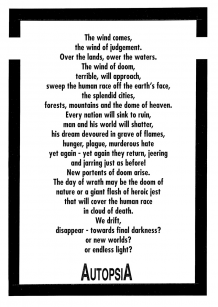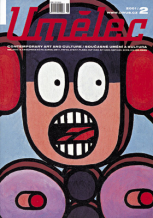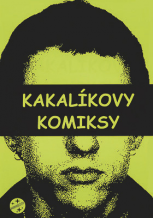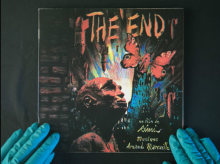| Umělec 2003/1 >> Notes from a tiny Asian island | Просмотр всех номеров | ||||||||||||
|
|||||||||||||
Notes from a tiny Asian islandUmělec 2003/101.01.2003 Audrey Wong | art project | en cs |
|||||||||||||
|
"In recent years, independent art spaces in Asia seem to feel the urgency of networking, building relationships among themselves. Perhaps this is the result of Asian art gaining more “currency” in the global art circuit — as curators (from the west) programming for major art shows include more Asian artists. The independent art spaces, often the first place to identify new artists, obviously end up playing a role. Now, as the eyes of the world turn to Asia — whether as a brave new marketplace (the anticipation accompanying China’s entry to the World Trade Organization, for instance) or a potential threat (such as concerns over the rise of a militant Islamic fundamentalism) — we Asians too are affected by the desire and anxiety to know ourselves better, as much to “protect” ourselves from neo-colonization as to search for what is genuinely our own. Through networking, the art spaces and artists who work with us build a community, which can offer us moral support in times of stress. This community also gives us opportunities to develop a better understanding of our vastly different cultures.
It is commonplace to talk about the conflict between “tradition” and “modernity” in Asia, particularly in urban centers like Singapore. We are still asking ourselves questions like “what is the contemporary in Asia?” For us in Singapore, the contemporary life is certainly characterized by urbanization, a faster pace of living, the creation of wealth and a focus on technology. In our race to catch up with the “First World,” we have put economics ahead of many other things. The prevailing Singaporean mentality has been that culture and the arts comes later, after every citizen has been fed, clothed and sheltered. In our rush towards “progress,” we left ourselves with no time to digest, absorb, reject, reclaim, our history(ies); to allow the emergence of symbols that speak to us; to let art emerge. In Singapore, it is often said that we have no sense of history: we even “erase” our past by getting rid of its physical traces such as buildings, landmarks, neighborhoods. The mentality of materialism and pragmatism remains ingrained in Singaporeans; it seems that we wish to control everything in our environment. This impacts on the way that the arts is viewed and received, by the public and the state. Today, the government sees the arts as part of its strategy to maintain Singapore’s prosperity. The bottom line of arts policy is twofold: first, more arts makes Singapore an exciting place to live in, creates an attractive image of Singapore, thereby attracting the world to invest in Singapore; second, that arts and culture will help generate a cultural identity that will keep Singaporeans united. To achieve these objectives, the government has put in intense efforts: such as grants to cultivate artistic appreciation in the people, developing a “festival culture,” building the massive new Esplanade arts center, sending Singapore artists to the Venice Biennale. A lot of the emphasis is on getting bigger and better — more major events, more audiences, more foreign attention. In 2000, the Ministry for Information and the Arts published the Renaissance City Report, which mapped out future directions in cultural policy. It suggested additional arts funding of $50m, which has since been pledged. Now artists are asking serious questions about how the money is flowing through the system. Did the injection of money have returns? What kind of returns? How can these returns be calculated? Returns to who? Sometimes it seems to me that the artists and the intangible that is “art” are forgotten amid the hype of the next festival, the next big cultural event. Artists who prefer to work on a small-scale, or who choose to step back, reflect and research, rather than become involved in a major, state-funded project, lose out in terms of funding, publicity and recognition. In a similar way, the independent art space also becomes overshadowed by the major biennales and arts festivals. Perhaps that is why independent-minded artists seek out these art spaces to work with. And by networking and grouping together, the small-scale, independent art spaces carve out a place for these artists; and perhaps, by working as a group, we can pool our limited resources better. Still, resources are scarce for these independent art spaces, like The Substation, where I work, even though we get some state funding. We are always devoting resources to finding new revenue streams, donations, sponsorships. It is an on-going struggle for survival and sustainability. In the state arts funding model employed in Singapore, the ideal is to have arts organizations funded through a three-way equal division of state funds, sponsorships/donations, and earned revenue. In reality, this ideal seems unreachable for most arts organizations. Obviously, businesses supporting the arts look for specific returns, either in terms of monetary returns or in terms of positive public image (which may lead to financial returns in the future). The bottom-line for corporate support isn’t always about the art. For independent art spaces which often take on experimental and risk-taking work, the audiences are usually too small to attract business support. Can a philosophy of corporate philanthropy be developed which also values the development and sustainability of artists and art spaces? Is a philosophy of sustainable development — which is already practiced in funding “third world” development — workable? Could we see funders and sponsors taking a longer-term view? In the arts, a project is as likely to fail as it is to succeed. The terms of success and failure in art are not always measurable in mathematical terms, such as the number of audiences, or the amount of works or tickets sold. In the end, even as we struggle for survival, we can never lose sight of the fact that our work is ultimately about art. While we have not attracted much corporate sponsorship lately, it is also true that The Substation has managed to survive for 13 years and largely kept to the legacy of intellectual openness, debate, support for diversity and artistic risk-taking established by its founder, Kuo Pao Kun. For us, achievement is also measured in non-quantifiable terms. For instance, working with an artist like Zai Kuning, whose work ranges from video to poetry to theatre, dance, performance art, music and installation art. He has exhibited at the Asia-Pacific Triennial and been invited to take part in other major shows, but prefers to pursue his own interests; lately, these included research into the “sea nomads” around the Riau Islands. Zai’s output of work may seem small in recent years, and audiences at his shows number in the tens, not thousands; but he is an inspiration for a younger generation of Singapore artists now coming into professional practice. The Substation Jun/July 2003 The Substation is Singapore’s first independent arts center. Its mission is to: nurture and challenge Singapore artists; provide an open space for artistic experimentation; promote interaction between diverse artists and audiences; facilitate critical dialogue in the arts; foster regional and international arts networks. Artistic Co-directors: Lee Weng Choy & Audrey Wong "
01.01.2003
Рекомендуемые статьи
|
|||||||||||||
|
04.02.2020 10:17
Letošní 50. ročník Art Basel přilákal celkem 93 000 návštěvníků a sběratelů z 80 zemí světa. 290 prémiových galerií představilo umělecká díla od počátku 20. století až po současnost. Hlavní sektor přehlídky, tradičně v prvním patře výstavního prostoru, představil 232 předních galerií z celého světa nabízející umění nejvyšší kvality. Veletrh ukázal vzestupný trend prodeje prostřednictvím galerií jak soukromým sbírkám, tak i institucím. Kromě hlavního veletrhu stály za návštěvu i ty přidružené: Volta, Liste a Photo Basel, k tomu doprovodné programy a výstavy v místních institucích, které kvalitou daleko přesahují hranice města tj. Kunsthalle Basel, Kunstmuseum, Tinguely muzeum nebo Fondation Beyeler.
|

































 We Are Rising National Gallery For You! Go to Kyjov by Krásná Lípa no.37.
We Are Rising National Gallery For You! Go to Kyjov by Krásná Lípa no.37.
Комментарии
Статья не была прокомментированаДобавить новый комментарий